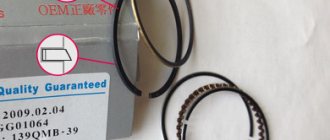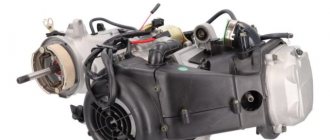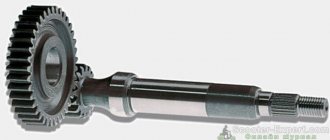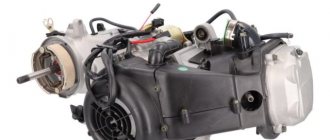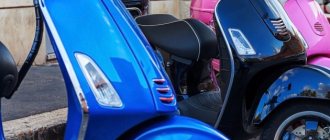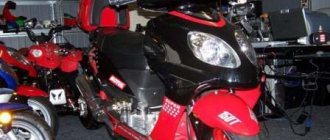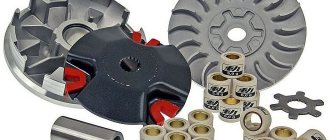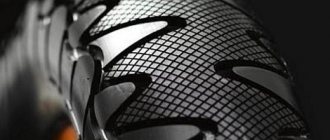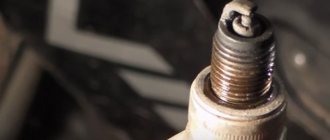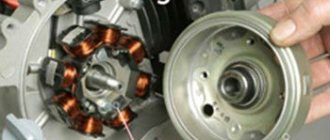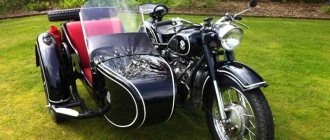Varieties of the 139 qmb engine
Displacement of an internal combustion engine.
Although Chinese scooters have been imported to Russia for more than eight years, to this day no one really knows what engine displacement is on their scooter. Some sellers themselves do not know what they are “pushing” to unlucky buyers. In most cases, what is written on the packaging box is what is told to the consumer. In fact, knowing the exact volume of your internal combustion engine is not so unimportant. For example, if you are tuning your favorite scooter, then this is simply necessary for you to further calculate the compression ratio and select the fuel (AI-92, AI-95, AI-98) on which your pet will ride. Many people don’t think about this, but due to the wrong choice of fuel, valves burn out, pistons burn out, muffler rings and partitions crumble, and now you’re in the workshop, and not on a beautiful country highway. To avoid all these problems, you need to know the following formula:
Using this formula, you can calculate the displacement of any engine. Once we know the engine displacement, we can correctly calculate the compression ratio and select the required octane number of fuel for your scooter.
In the previous article (Calculating the working volume of an internal combustion engine), we told how to correctly calculate the working volume of the engine, hereinafter V-slave.
Formula for calculating the compression ratio
Σ = (Vwork + Vks) / Vks
The compression ratio should be: AI-92: from 9.5 to 10.5 AI-95: from 10.5 to 11.5 AI-98: from 11.5 to 13
Scooter engines: review of Chinese models 139QMB and 157QMJ and D1E41QMB
Scooter engines: review of Chinese models 139QMB and 157QMJ and D1E41QMBDespite all the variety and variety of Chinese scooters on Russian roads, their engines belong to only two categories. This is a two-stroke scooter engine and a four-stroke one.
These categories differ greatly in the number of models produced, so let's start with the largest category - the 139QMB four-stroke scooter engine. Its history began at the end of the last century, when in the 90s the Honda branch developed the first such scooter engine model, and today it is called KYMKO. Ten years later, China adopted this development and, together with Honda, began mass production. How good the final version turned out can be judged by the fact that scooter engines labeled 139QMB are regularly purchased from Japan and sold there under the Honda brand.
The 139QMB scooter engine has already become a legend in the motorcycle world, and Hongling Corporation, which officially produces it, installs this engine not only on motorcycles of its own brand, but also successfully sells them for assembly at prices of other motorcycle brands. The recognition of this scooter engine is simply colossal: the marking is located on the left side of the crankcase. The serial number begins with 139QMB, followed by the product number in the production batch.
Viewed products
- Who are we
- Vacancies
- Contact details
- Payment
- Delivery
- Low price guarantee
- Availability and prices
- Credit
- Installment plan
- Returns and exchanges
- Promotions and discounts
- Commission
- Feedback
- Visit of the master
- Tuning
- Motor vehicle assembly
- ATV repair
- Motorcycle repair
- Scooter repair
- Maintenance
- Moto tire service
- Motor tow truck
- Storage
Error
Login to your personal account
Any questions?
Product added to cart
Terms of free delivery
Products from categories:
Motorcycles Tracks Yoke Radiator removal Doors Rear carrier Underbody protection Fender protection Buckets Overhang reduction kit Roofs UTV Trunk guard Snow blades Front carrier Footboards Trailers for ATV Sleds and accessories Tires -> ATV, UTV Tires -> Road, sports Tires -> Cross Tires - > Scooters, mopeds Tires -> Enduro Original spare parts for Japanese and European brands (as agreed) Commission and used goods (as agreed)
Delivery period.
— If the product is in stock, the order is delivered within 1-2 business days from confirmation of the order and receipt of payment. The guaranteed delivery time is 5 working days from confirmation of the order and receipt of payment. — If one or more products in the order are out of stock, our manager will contact you and inform you of the order completion date. — Orders are delivered on the following days:
Monday from 11.00 to 19.00 Tuesday from 11.00 to 19.00 Wednesday from 11.00 to 19.00 Thursday from 11.00 to 19.00 Friday from 11.00 to 19.00
Other delivery days and times are discussed individually.
Delivery by transport company
1. TC ZhelDorExpedition https://www.jde.ru/ 2. TC Business Lines https://www.dellin.ru/ 3. TC SDEK https://www.edostavka.ru/ 4. TC KIT https:/ /tk-kit.ru/ 5. TK Energy https://nrg-tk.ru/
Delivery by default is carried out to the TK terminal in your city. You can find out the address and operating hours of the TK terminal in your city by going to the transport company’s website.
The order can be received by the person in whose name the order was placed upon presentation of a passport of a citizen of the Russian Federation.
To select a delivery city, start entering its name in the “Location” field, and then select the desired option from the proposed list
If there is no TC branch in your city, you will not be able to select it. In this case, use the Postal delivery method.
The delivery cost calculation is approximate; the exact cost is determined when sending the order.
Payment of delivery costs occurs upon receipt of the order.
Delivery period.
You can calculate the order delivery deadline yourself by using the calculator on the website of the shopping center you need, or contact our managers. It is worth considering:
— The indicated delivery time is approximate.
— If the product is in stock, the order is dispatched within 1-2 business days from the moment the order is confirmed and payment is received. The guaranteed dispatch time is 5 working days from the date of confirmation of the order and payment for the order.
Engine Features
The official manufacturer of the 139QMB scooter engine is Hongling Corporation, which equips motorcycles not only of its own brand, but also of other brands with this engine.
The corporation sells power units to other manufacturers. The motor itself is very recognizable: the design features of the 139QMB engine and its markings on the left side of the crankcase immediately make it clear what kind of heart beats the scooter.
The motor has no flaws, does not require special treatment and calmly tolerates minor negligence and negligence. The manufacturer provides a guarantee for its products that covers the first 5 thousand kilometers. This mileage is enough for the new 139QMB 4t scooter engine to fully run in and grind in all elements and components of the systems.
The total service life of the engine is about 20 thousand kilometers, with the exception of 5 thousand running-in at an average driving speed of 90 km/h. The technical characteristics of the 139QMB engine are not bad: its power is enough for a two-seater full-size scooter.
When to adjust valves
Experts recommend carrying out the first adjustment of the unit and diagnosing backlashes after the first 500 km of motor vehicle mileage, and 5-7 thousand km thereafter.
Service work will also be required when troubleshooting engine problems, characteristic sounds, loss of power during acceleration, or when the bike stalls and it is impossible to start it.
To carry out repair work you will need a minimum set of keys and tools:
Probes Attention!
The clearances on the scooter valves must be strictly 0.05 for the upper and 0.1 for the lower, so the feeler gauges must be exclusively of the same thickness.
Engine markings for Chinese scooters! Let's sort it out piece by piece.
Each motor of “rice” scooters has its own marking, which encodes the features of a particular unit. During scheduled scooter repairs (or unscheduled ones), many owners encounter some difficulties in finding spare parts, because they search for the main parts by the model name and not the engine marking. To do this, I recommend that you carefully examine the scooter’s engine, and after washing it of oil and dirt, find engraved numbers and Latin letters there. Most often, the location of these inscriptions is in two places:
Quite often I see how on forums and thematic groups on social networks, fans of the Chinese motorcycle industry argue that, for example, 152QMI and 157QMJ are different engines in principle. Let's figure out what all these numbers and letters mean. The first digit “ 1 ” ( 1 39QMB) in the marking will indicate that the engine has 1 cylinder. If you suddenly see the number “2” - go nuts, the scooter’s engine is two-cylinder. The letter “P” (1P39QMB) indicates that the cylinder is in a horizontal position. If the letter “P” is missing, then the cylinder on the scooter is not necessarily horizontal. So 139QMB and 1P39QMB, whatever one may say, are the same engines. The next two digits in the designation are “39”, “ 52 ”, etc. (1 52 QMI) denote the internal diameter of the cylinder liner, and accordingly the diameter of the piston and rings in the piston group. The first letter speaks about the scooter’s cooling system: “F” (139FMB, 1P39FMB) - air cooling of the motor occurs by free flow;
“Q” (139QMB, 152QMI, 157QMJ) - forced air cooling, there is a blower casing on the cylinder. If the letter is missing, the engine is most likely water-cooled (172MM - CH250). The second letter is the engine type: “M” (139QMA, 139FMA) - motorcycle engine. The third letter in the marking corresponds to the working volume of the cylinder-piston group of the scooter: “A” - up to 50 cubic meters (139QMA) - “honest” fifty dollars); “B” - up to 70 cubic meters (139QMB) - the most common, “almost honest” half-shock, which according to the rules should be labeled as 147QMB or even 150QMB;
"G" - up to 100 cubes; “H” - from 100 to 125 cubes (a rare variety of the GY6 family);
“I” - from 120 to 130 cubic meters (152OMI);
“J” - from 150 to 155 cubic meters (157QMJ);
Summarize:
1. It is better not to buy a CPG without identification marks (“noname”). 2. CPGs of famous Chinese brands are approximately the same in price and quality. You can install such CPGs, but you shouldn’t count on their durability. 3. Taiwanese CPGs have a good price/quality ratio. It is advisable to make a choice towards more expensive CPGs based on the general condition of your equipment, taking into account the prospects for further operation. 4. Tuning the CPG of a Chinese scooter is an individual matter, and if you’re going to “tune” it, it’s better to do it comprehensively. 5. Every owner should install 70cc on the 139QMB engine (just kidding).
Thank you for reading to the end. I look forward to your comments or additions.
PS I didn’t consider Italian CPGs; what’s the point of buying a CPG that costs the same as an entire Chinese scooter.
You can select and buy a CPG for your scooter or moped in our store:
CPG for scooters CPG for mopeds Alpha Delta
Analogues - engine 1P39QMB
Chinese developers have created an analogue of the Japanese 139QMB engine - a motor labeled 1P39QMB, which in appearance completely replicates the original. Despite all the similarities, you can still find differences: the valve clearances on the 1P39QMB are not adjustable. The situation is similar with the carburetor: before direct operation it requires thorough cleaning and correct adjustment. Chinese copies of 139QMB engines, of course, cope with their task, but their main purpose was to reduce the final cost of motor vehicles. Budget versions of scooters are equipped with exactly the same versions of engines that are good only for short trips at low speeds.
Comments • 70
I thought I was the only one with a broken crankcase cover
The marks do not match because the chain is not original, it’s not a bit scary, I also had this happen and it starts and drives well, so it’s normal.
If the chain is new, then it’s better the other way around!
How did the piston perform, how long was it enough and how did the engine perform?
God forbid you trust such a deer with anything; he will even break something that doesn’t break.
Video on how to make it.
If possible, send it to Viber or WhatsApp. 0500174258
Thank you for the video tutorial on qmj139. If possible, show me how you made a stand for mounting the engine in a horizontal position.
I don’t understand what he wants to achieve, the marks are clearly visible, there’s no need to reinvent the wheel, everything is clear here, one tooth forward, late ignition, one tooth back, early, and this mark makes the crankshaft knock just right along the way
Why change the chain so that the engine doesn’t stab, I can’t figure out how?
You don’t have to prick, you need a pipe approximately 35 mm in volume to drill a 4 mm hole approximately at the level of the cylinder, and then use your wits
No way, no motor will work like that.
Young Skywalker, your valves are knocking, can't you hear?
hahahaha the gap is almost like a Lada
Bestalach. Who puts marks without a chain tensioner?
There should be a shortfall because it is a gasoline engine, not a diesel one.
Markers can be set with spacers
Friend. When I installed new rings, I didn’t know that they had to be installed with the mark and the mark facing up, and now I don’t know how I installed them. What could happen and is it worth taking it apart again? If you take it apart, do you have to put new gaskets in again? The moped hasn’t been ridden yet, but it rattled with half an hour in place. In general, some kind of garbage with it, after installing a new piston, it started up very quickly, turned it off and started it, no problems. The next day it didn’t start at all. Then I twisted the spark plugs in the evening, it started up and started it several times. The next day again It didn’t start, then it started again. I got tired of it in short. There is always a spark, gasoline too, the spark plug is wet.
These valves will not work; I do not recommend installing this piston; they may not withstand the bearings on a 60 cc crankshaft and will travel longer
I don’t agree with the gaps, I opened the valve covers while hot and the gaps recommended in the manual turned out to be with a reserve!
And still it is necessary to break in the new CPG? And if necessary, how?
I have the same engine and the engine doesn’t pick up and after how many miles I need to change the engine chain, please tell me
Bro, you just assembled the engine with a new piston. How high are you revving? they see enough of people like you and then they drive without running in, and in the end the master is a bad one. If you decide to convey information to people, do it competently and efficiently.
Curious, what are you planning to test there? Rings? Well, they have a thermal gap from the factory. Are there any other options? The breaker is unfinished.
but it’s most likely not running because of the ignition) and because one valve is clamped and the other is loosened by a lot.
I didn’t even watch it to the end, I just rewound it. so here it is. The engine runs but the valves can be heard terribly. I don’t know the meaning of your work at all..
Was there any point in making a new dead center? If you put it on it, then all the factory marks will be there. and the camshaft is in its place..
But what if I put a piston with rings into a cylinder at home, it doesn’t move well?
and what if when you tighten the cylinder head gaskets they will press a little bit and instead of 2mm there will be about 1mm
Hello everyone, the Horse 058 scooter, while on the move it stalled, when I tried to start it, it seemed to jam (it turns the starter hard) when you remove the wire from the spark plug it turns normally, I adjusted the ignition 5 times, the crankshaft is normal, the rings were recently changed, what the hell is this?
Mikhail Novogradov Grandfather Mish, what you say is correct!
4:31 if you install a chain guide, it will align and the marks will be parallel (it is imperative that the upper hole looks larger than the lower one)
The calmer has nothing to do with it, there is no automatic, as I set it up it will be so
Hello. Your idle is clear. What kind of carburetor is it?
I'm sorry, I collected a 150cc motor like you, but it smokes a lot from the exhaust and doesn't gain full power
Engines 157QMJ
In addition to the very popular model - the 139QMB engines - Hongling Corporation produces other versions of power units, one of which is the 157QMJ. It is installed on expensive scooter models of famous brands. In terms of its technical parameters and indicators of functionality and reliability, this version is a complete analogue of 139QMB. In addition, the design features of the model are strongly reminiscent of other mass-produced Japanese engines.
The advantage of the 157QMJ is its increased service life - about 25 thousand kilometers. The engine boasts powerful dynamics and a high top speed. However, it also has its downside - the price is too high compared to previous versions of the engines.
Piston installation
Insert a retaining ring into any boss of the piston pin. It is most convenient to insert the ring with small round nose pliers. After installation, check how well and tightly the retaining ring fits.
Lubricate the bearings of the lower and upper connecting rod heads and the piston pin bosses with clean engine oil. We put the piston on the connecting rod, orienting it with the “IN” mark to the inlet port; if there is an “arrow” on the piston instead of the “IN” mark, orient the arrow to the exhaust port. We insert the piston pin into the boss - orient the piston on the connecting rod so that the pin hits the connecting rod - install the pin all the way into the locking ring and secure it from falling out with the second locking ring.
We install the cylinder guide bushings on the studs and put on the gasket. It is advisable to place the gasket on the sealant, but without fanaticism.
Maintenance of zero vehicles
In principle, servicing tuning filters is no different from servicing standard ones. The filter element is cleaned by blowing air in the direction opposite to suction.
There are also types of filters that can be washed. It all depends on the material from which the zero is made. The possibility of washing is usually indicated by the manufacturer. It is necessary to make a reservation that most of the zeros are still disposable. It is impossible to completely wash out dust particles from a heavily soiled filter. Even after thorough purging or washing, its throughput will be lower than that of a new one.
For washable filters, maintenance boils down to rinsing it in water with a detergent solution and then drying it. The manufacturer specifies what exactly to use for washing.
Important: washing the filter with products not recommended by the manufacturer can damage it!
For engines with insufficient power, such a filter is needed
What oil should I use?
Available types of oils for four-stroke engines: SAE 5W-20 or 10W-40. Depends on the manufacturer. If the vehicle is often operated in high temperature conditions, it is better to choose a motor oil with a high viscosity index.
What to look for when choosing oil? First of all, on the oil indices, which should be present on the canister label. The chemical composition is also no less important. In addition to the index, the exact amount of additives from the fluid manufacturer is used.
For a four-stroke scooter engine, you can use not only oil that is intended for scooters, but also for equipment: walk-behind tractors, lawn mowers, chainsaws and others.
Engine D1E41QMB
The D1E41QMB motor is the only two-stroke engine model made in China. A distinctive feature of this engine from other representatives of the category of power units is the presence of a chain reverse gear in the design. The uninterrupted operation of such an engine is ensured by mixing gasoline and oil in proportions of 40 to 1. The working life of the engine is about 10 thousand kilometers, after which the need for repairs arises. The disadvantage of the engine is the forced speed limit - no more than 50 km/h.
Specifications
| Release | 2019 |
| Colors | Great choice |
| Engine capacity | About 150 cm.3 |
| Speed | Up to 90 kilometers per hour |
| Power | 9.5 hp |
| Muffler | Material aluminum |
| Motor | Japanese four stroke |
| Transmission | Presented with automatic variator |
| Brakes | Disc version |
| Ignition | Electronics |
| Cylinders | 1 PC |
| Fuel supply | Carburetor |
| Used | AI 92 |
| Start | Kickstarter |
| Transported cargo | No more than 150 kg |
| Cooling | Air force |
| Tires | R-13 |
| Frame | Steel pipe |
| Steering wheel | Rubberized handles |
| Weight | 112 kg |
| Seats | Spacious for 2 people |
| Optical system | 2 mirrors |
| Mirror housing | Durable aluminum |
| Signaling | Audio system, triggered by a mobile phone call |
| Shock absorber | 2 |
| Front suspension | Telescopic fork |
| Rear suspension | Rocking fork |
| Dimensions | 1880/700/1170 (l-w-h) |
The characteristics are quite satisfactory for scooter lovers. The equipment is good.
The scooter has good equipment
Motor characteristics
The Vulcan scooter engine is 150cc four-stroke.
Speed up to 90 km/h. When replacing parts, refer to the markings. Write it down before using it.
Numbers and Latin letters are stamped in two places on the engine:
- on the crankcase under the front variator cover, at the bottom;
- near the gearbox on the engine crankcase.
We find spare parts by markings.
There are 2 markings:
- 139QMB;
- 1P39QMB.
- The number 1 denotes 1 cylinder, P - its horizontal position. If there is no “P”, then horizontal placement is not necessary;
- The numbers “32”, “52” indicate the internal diameter of the cylinder and piston;
- “F” - air flow cooling of the motor (1P39FMB);
- “Q”—forced cooling. A blower casing is installed, if there is no letter - water cooling (139FMB, 152QM), (172MM);
- “M” - motor type (139QMA) motorcycle;
- The third letter volume is “A” 50, “B” 70, “J” 150-155.
The Vulcan 150 model has a “J”.
The key to a long service life of a scooter is high-quality running-in
Exploitation
There are 2 periods: run-in and normal.
It is necessary to break in a scooter after purchasing a new one or after repairs have been carried out. The parts and gaskets are grinding in and the motor is in thermal mode. High-quality running-in is the key to long service.
- A smooth, level road with a dense surface is selected; crushed stone is not suitable;
- the speed limit is set to medium, 60-70 km/h;
- you cannot overload the engine, transport heavy loads, ride with a second person, or climb a hill;
- warm up the engine before driving;
- running-in duration is 1000 km;
- Do not switch modes abruptly.
Up to 150 km:
- do not allow the engine to operate for long periods of time with the throttle handle turned more than 1/3 of a revolution;
- stop every 10 minutes to cool the engine;
- Change speed frequently.
After purchasing new equipment, it should be run in
after 150-500 km:
- you need to wash the filter and change the oil;
- Turn the throttle handle ½ turn for a short time.
500-1000 km;
- briefly turn the handle ¾ turn;
More than 1000 km:
- turn the handle completely.
For all modes, change the speed periodically.
While warming up, monitor the rotation of the crankshaft. Rapid rotation will cause jamming.
There are few fans of winter driving. When storing the scooter, drain the gasoline. In cold weather, the fuel changes its structure and the carburetor becomes clogged.
Winter trips:
- add new fuel;
- check the tire pressure, reduce it to 1.5 atmospheres;
- charge the battery;
- replace old spare parts;
- check the oil level;
- filter condition;
- clean the air filter;
- lubricate brakes and cables;
- warm up for 5 minutes.
Summer:
- avoid overheating. Prolonged driving at a temperature of 30 degrees leads to overheating of the cylinder. As a result, the belt often breaks and engine problems arise;
- do not pinch the throttle;
- Do not turn off the engine quickly.
Compliance with all rules will ensure long service life for your scooter.
Long service life for your scooter will ensure compliance with all rules
Weight and dimensions
This brand is close to a motorcycle.
Length 1880. Width 700. Height 1170 cm. Takes up little space. Parks everywhere.
Weighs only 112 kg. Maneuverability is good, traffic jams are not a problem.
Brake device
Disc brakes, fractional type. Installed on both wheels.
The disk is a moving part. Caliper with brake pads - fixed.
Complete with:
- caliper (bracket);
- cylinder;
- pads;
- disks.
The caliper is mounted on the steering knuckle. It moves horizontally. Inside there is a brake cylinder and a piston; it presses the pad-plates to the disc. A fitting is installed on the housing; air entering the system is removed through it (the cause of poor braking).
Scooter wheels are made from perforated steel
Brake pads are metal with friction linings. They are placed on the sides of the disk and secured to the wheel hub.
- When you press the brake pedal, the pressure in the fluid-filled tubes increases;
- the fluid presses on the pistons of the working brake cylinders, the pads are pressed against the disc;
- speed decreases;
- release the pedal - the pressure decreases and the disk is released.
Scooter rims are made of perforated steel. The larger it is, the better the brakes.
Wheels
A safe trip depends on inflating your tires. Before leaving, check with a monometer. The norm for inflated wheels is rear 20, front 1.75 atm. When pumped, it has weak adhesion to the road surface. You can fall when turning.
Running in the engine
Incorrectly carried out running-in of the 139QMB engine in most cases leads to failure of the piston system. Friction occurs between the parts of the new CPG, which leads to an increase in engine temperature.
Running in the scooter motor is carried out as follows:
After carrying out such manipulations, you can run in the scooter itself. In the first 100 kilometers of the journey, you should not turn the throttle handle more than 1/3 of its full stroke. The maximum speed should not exceed 30 km/h. The speed can be increased by 15–20 km/h for the next 300 kilometers - during this time the engine should more or less reveal its potential.
After this break-in process, the oil must be changed.
Engine valves are adjusted every 500 kilometers.
Installing piston rings
Remove the set of piston rings from the box. A piston ring set for a Chinese four-stroke scooter usually consists of five items. Three of which are a single assembled oil scraper ring, the other two: upper and lower compression.
A typical set of piston rings looks something like this
Carefully unpack the kit with perfectly clean hands.
In the kit you will find two of the thinnest rings and one thick corrugated ring (expander) - this will be an assembled oil scraper ring that needs to be installed on the piston first.
We place an expander in the lowest groove of the piston
We place thin oil scraper rings in the same groove - one under the expander, the second on top of the expander
We find the lower and upper compression rings in the kit and install them, respectively, in the middle and upper grooves of the piston - with marks on the side surface to the cylinder head (cylinder head). The lower compression ring differs from the upper one in color (not always) and the shape of the working edge (always). In most kits, the lower compression ring is painted black, and its working edge has a slight bevel.
The top compression ring in the vast majority of piston ring sets is a uniform light color. But this is in most cases, and in practice it happens that the kit comes with upper compression rings that are black or even red. By and large, the color is not particularly important to us, something else is important to us: the working edge of the upper compression ring has small roundings (chamfers) on the sides, and the working surface of the edge of the upper compression ring is covered with a shiny protective coating.
Engine tuning
The first thing they try to change when tuning the 139QMB engine is the cubic capacity. For this purpose, the standard piston system is replaced with an 82cc one. At the same time, a new cylinder head with enlarged valves is installed. The piston system changes along with the camshaft, since a larger amount of fuel-air mixture is required for its correct operation. A new camshaft will help increase the volume of the incoming fuel mixture, but the carburetor will still need to be replaced.
Setting the valve timing ch2 (in collective farm style - ignition)
Without knocking the piston off from TDC, we orient the camshaft so that the large hole and marks on its sprocket become as shown in the photo and, while putting on the chain, install the camshaft in bed.
Ideally, the marks on the sprocket should be strictly parallel to the plane of the valve cover connector. In practice, unfortunately, such accuracy is difficult to achieve. And this is mainly due to the stretching of the timing chain. And there’s nothing you can do about it - either change the timing chain to a new one or catch the phase by switching the teeth, but this method of setting the valve timing is not acceptable to me personally.
We orient the camshaft bed with a mark in the form of the letters “E” and “X” towards the exhaust channel and install the bed.
Tighten the bed nuts crosswise and then tighten the two bolts on the side boss of the cylinder head.
Air filter
It is not recommended to completely remove the filter element or replace it with a zero-resistance filter - this can lead to contamination of the carburetor. Experts usually recommend removing the plug that is installed at the inlet of the air filter.
Many reviews that affected the assembly of the 139QMB engine after tuning talk about installing a zero-resistance air filter. Despite the fact that this solution is one of the most popular, it is not always appropriate and justified.
The reason lies in the fact that installing such a filter leads to rapid contamination of the carburetor. The main reason for using a zero resistance filter is the need for a richer fuel mixture after installing a larger piston. However, this can be avoided by installing a new camshaft and replacing the jets in the carburetor.
Separately, it is worth noting that a standard carburetor equipped with a 16 mm diffuser is installed together with a 62–72cc piston system, while the 82cc piston system is equipped with a carburetor with an 18 mm diffuser.
For replacement, it is advisable to purchase a set of jets, since several different options may be needed to adjust the carburetor.
Cylinder installation
Fill the rings and piston with clean engine oil. We tighten the piston rings with a clamp. We cut the clamp from a piece of any sheet metal - cut out a strip of the required length, give it a profile along the piston and make a retainer from the same piece of sheet metal.
Lubricate the cylinder mirror with clean engine oil
We hook the timing chain with a piece of wire, pull the chain through the cylinder and put the cylinder on the studs.
Very carefully and slowly insert the piston into the cylinder. After the rings are completely inserted into the cylinder, unfasten the clamp and install the cylinder into the crankcase.
Medium and high speed tuning
The quality screw prepares the mixture ratio at idle. Failures in operation at high modes are eliminated in other ways.
After opening the throttle valve, the fuel nozzle comes into operation. Its task is to supply gasoline to the diffuser while the scooter accelerates.
An incorrectly selected nozzle leads to deviations in the composition of the fuel mixture. During power build-up, the scooter may “suffocate”, until the engine stops completely.
The correct algorithm for tuning the carburetor at high speeds:
- cleaning internal channels from debris;
- checking the fuel level in the float chamber;
- adjusting the shut-off valve (needle) stroke;
- checking the jet's nominal value.
A sign of proper operation of 2t and 4t engines is a sharp increase in speed when the gas is opened. Any deviations from the stability of engine acceleration indicate a violation of the settings.
Signs of deviation in mixture preparation
An important indicator of the quality of fuel combustion in the cylinders is the color of the spark plug. An experienced mechanic only needs to look at its condition to understand what adjustments need to be made.
There are two characteristic colors:
- A white (grey) spark plug means the mixture is lean, the moped overheats and does not produce optimal power.
- Black with soot – excess fuel, excessive consumption.
The behavior of a scooter with an incorrect fuel mixture is specific:
- abnormal reaction to the throttle;
- pops in the muffler;
- smoke content of exhaust gases;
- noticeable decrease in power characteristics;
- sudden engine stop.
A normal moped spark plug is brownish in color. There should be no carbon deposits on it, its electrodes should be clean, without traces of melting.
Carburetor and its types
This device prepares and doses the air-fuel mixture, which then goes into the cylinder. Modern carburetors come in three types:
- spool valves;
- constant vacuum;
- register.
All domestic engines, as well as the Ural motorcycle engine, have spool carburetors. The only exception is the Ural-Vostok, which has a constant vacuum carburetor.
In a spool-type carburetor, the throttle handle is connected to the spool. By acting on it, the air entering the motor is regulated. A conical needle is connected to the spool and enters the sprayer. When it changes, the mixture becomes richer or leaner. A fuel nozzle is installed on the sprayer. And together all the elements make up the dosing system.
In constant vacuum carburetors, the movement of the throttle handle is transmitted to the throttle valve, which is located closer to the outlet of the carburetor. The air in the chamber above the spool interacts with the carburetor mixing chamber. It turns out that the movement of the spool is controlled by the vacuum in the intake tract.
Register carburetors, which are equipped with many foreign single-cylinder four-stroke engines, such as Honda engines, combine the two previous types. It has two mixing chambers, where in one the spool is driven by the handle, and in the other by the vacuum in the mixing chamber.
Removing the generator
But with a generator it’s not so simple. The generator can only be removed with a puller. All your attempts to knock down the rotor with a hammer or pry it out with a crowbar are doomed to failure.
Unscrew the bolts on the cooling impeller and remove it and the rotor
Fix the rotor with a puller and unscrew the nut (right-hand thread)
Install the puller and pull the rotor off the crankshaft journal
We blow out the generator, unscrew the bolts and put it somewhere away
